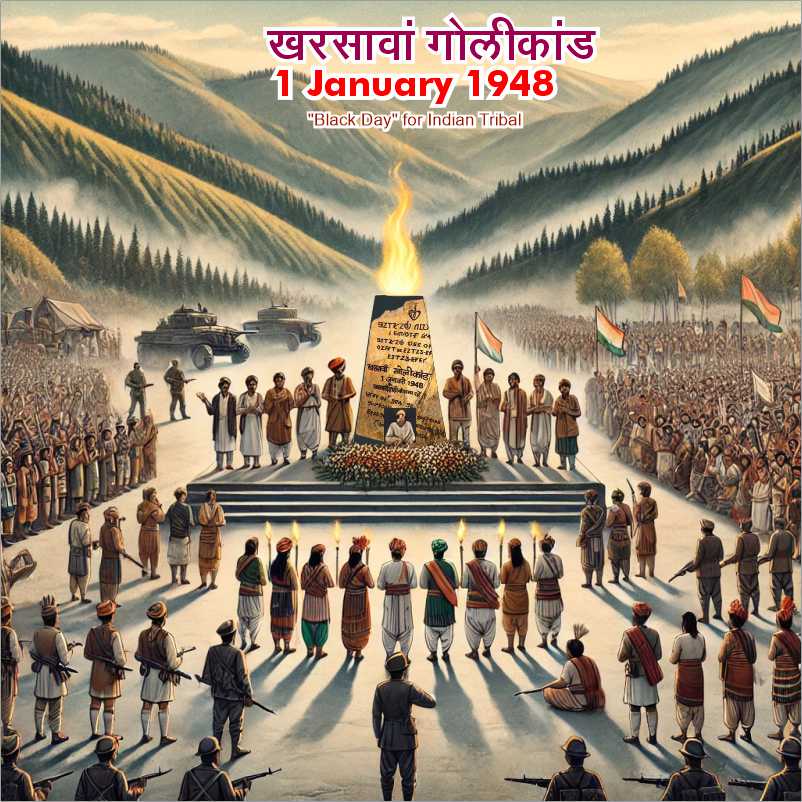The Kharsawan Massacre of 1948: Black Day for Indian Tribal People

The Kharsawan Massacre of 1948, often referred to as the “Black Day” for Indian tribal communities, remains a dark chapter in India’s post-independence history. This tragic event, which unfolded in the princely state of Kharsawan, now part of Jharkhand, epitomizes the struggle of tribal communities against systemic marginalization and their fight for dignity and autonomy.
Historical Context
The massacre took place in the aftermath of India’s independence in 1947, during the turbulent period of integrating princely states into the Indian Union. The princely state of Kharsawan, with its predominantly tribal population, faced a critical decision about its political future. Tribal communities, particularly the Adivasis, had a strong desire for self-governance and autonomy. They aspired to preserve their cultural identity and sought either a separate state or greater autonomy within the Indian framework.
This sentiment was championed by Jaipal Singh Munda, a prominent leader of the Adivasi Mahasabha, who advocated for the rights of tribal people. He envisioned the creation of a tribal state that would address their unique socio-economic and cultural needs. However, these aspirations came into conflict with the Indian government’s agenda of national integration, which often overlooked the concerns of indigenous communities.
The Massacre
On January 1, 1948, thousands of tribal people gathered in Kharsawan to peacefully protest the merger of the princely state into Bihar. This gathering was a significant expression of their collective identity and opposition to forced integration. The protesters’ demands were rooted in their desire for autonomy and recognition of their distinct cultural heritage.
Tragically, the peaceful demonstration took a horrific turn. The armed forces of the Indian government, in collaboration with the local administration, opened fire on the unarmed crowd. The brutal attack left hundreds of Adivasis dead, although the exact death toll remains uncertain. Eyewitnesses recount harrowing scenes, with bodies reportedly disposed of in nearby rivers and forests to downplay the scale of the atrocity.
Aftermath
The Kharsawan Massacre had a lasting impact on the tribal community and their relationship with the Indian state. It symbolized the systemic neglect and violence faced by tribal populations and became a rallying point for their movements. Despite the tragedy, the incident galvanized the tribal struggle for justice and autonomy.
Jaipal Singh Munda’s leadership remained a beacon of hope for the community. His relentless advocacy for tribal rights played a crucial role in the eventual creation of the state of Jharkhand in 2000. The state was carved out of Bihar to address the aspirations of its tribal population, marking a significant milestone in their long-fought battle for recognition and self-determination.
Legacy and Commemoration
The Kharsawan Massacre is commemorated annually in Jharkhand as a reminder of the sacrifices made by tribal people. Memorials and gatherings honor the lives lost and reiterate the importance of preserving tribal heritage and rights. Despite these efforts, the incident remains largely absent from mainstream national narratives, underscoring the need for greater acknowledgment of tribal histories.
In Kharsawan today, the “Shaheed Sthal” (Martyrs’ Memorial) serves as a poignant reminder of this tragedy. Tribals from various parts of Jharkhand and neighboring regions visit this site to pay homage to those who sacrificed their lives for the cause of autonomy. These commemorations emphasize the need to preserve the memory of such events for future generations and highlight the historical significance of tribal resistance movements.
Broader Implications for Tribal Rights
The Kharsawan Massacre exemplifies the broader challenges faced by tribal communities across India, who have historically struggled for land rights, cultural preservation, and socio-economic development. The massacre serves as a case study in the consequences of sidelining indigenous voices in decision-making processes. It also underscores the importance of inclusive policies that respect the autonomy and unique identity of tribal populations.
The resilience shown by the Adivasis of Kharsawan inspired other tribal movements across the country. From the Naga struggle in the Northeast to the Gond and Bhil uprisings in central India, the Kharsawan Massacre resonated as a symbol of the cost of suppression and the unyielding spirit of indigenous people.
Conclusion
The Kharsawan Massacre of 1948, known as the “Black Day” for Indian tribal communities, is a somber reminder of the struggles faced by Adivasis in post-independence India. It highlights the resilience of tribal people and their unwavering fight for justice and autonomy. As we reflect on this tragic event, it is crucial to ensure that such episodes are not forgotten but are instead recognized as integral parts of India’s history, fostering a more inclusive narrative for future generations.
Remembering Kharsawan is not just about acknowledging a dark past but also about reaffirming the commitment to tribal rights, justice, and equality in a rapidly modernizing India. By bringing these stories to light, we honor the sacrifices of those who stood against injustice and pave the way for a more equitable future.
